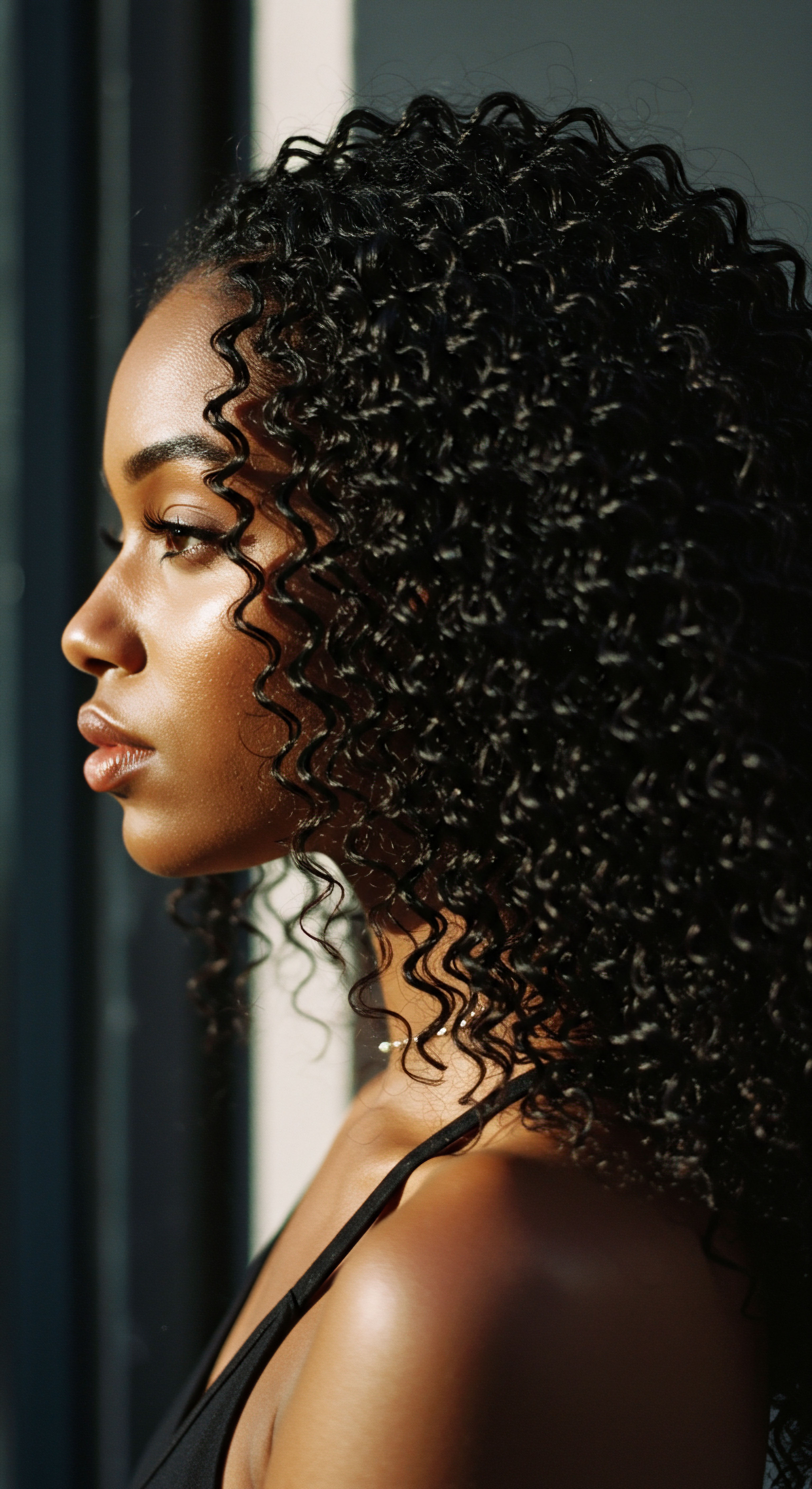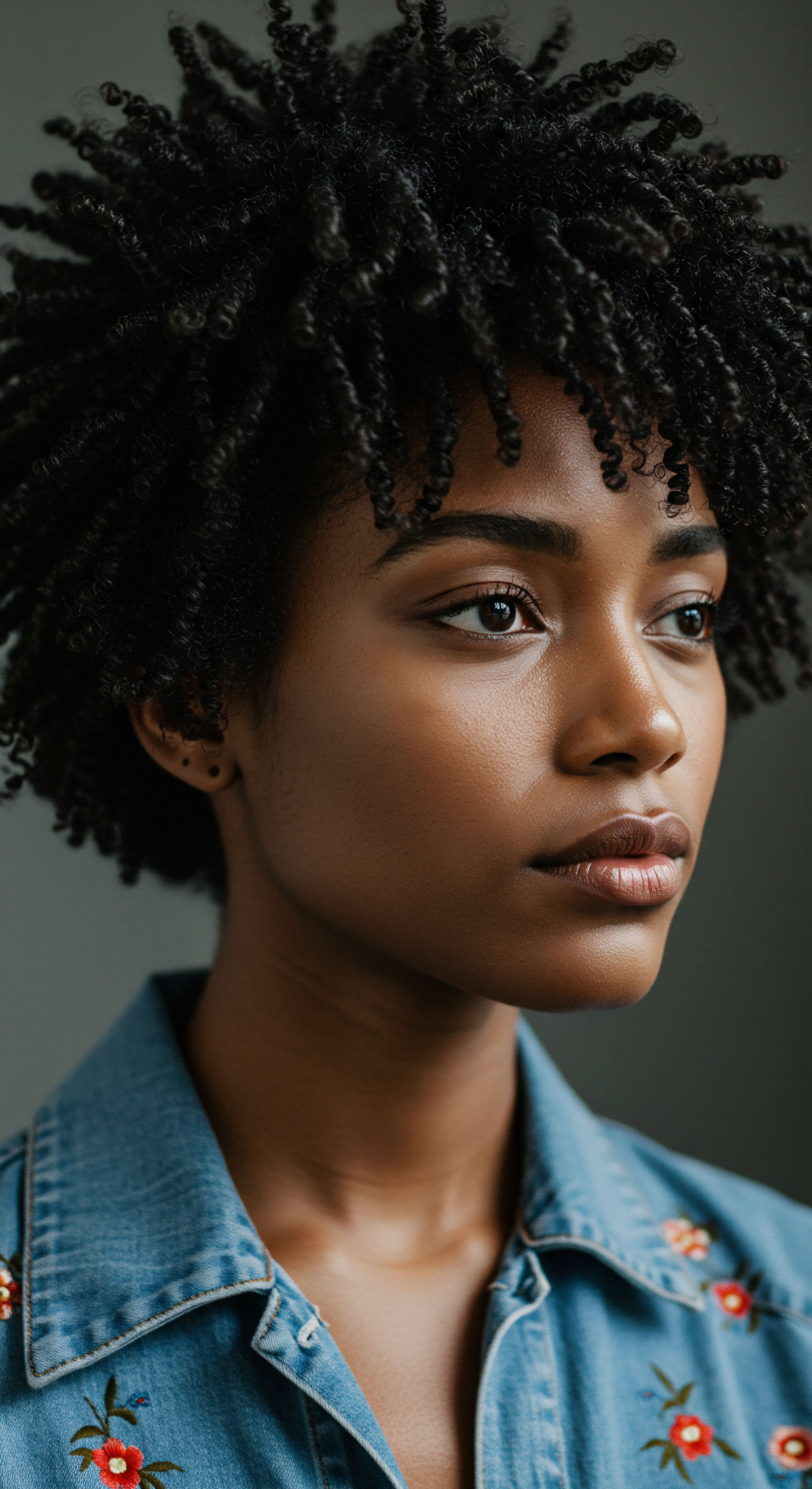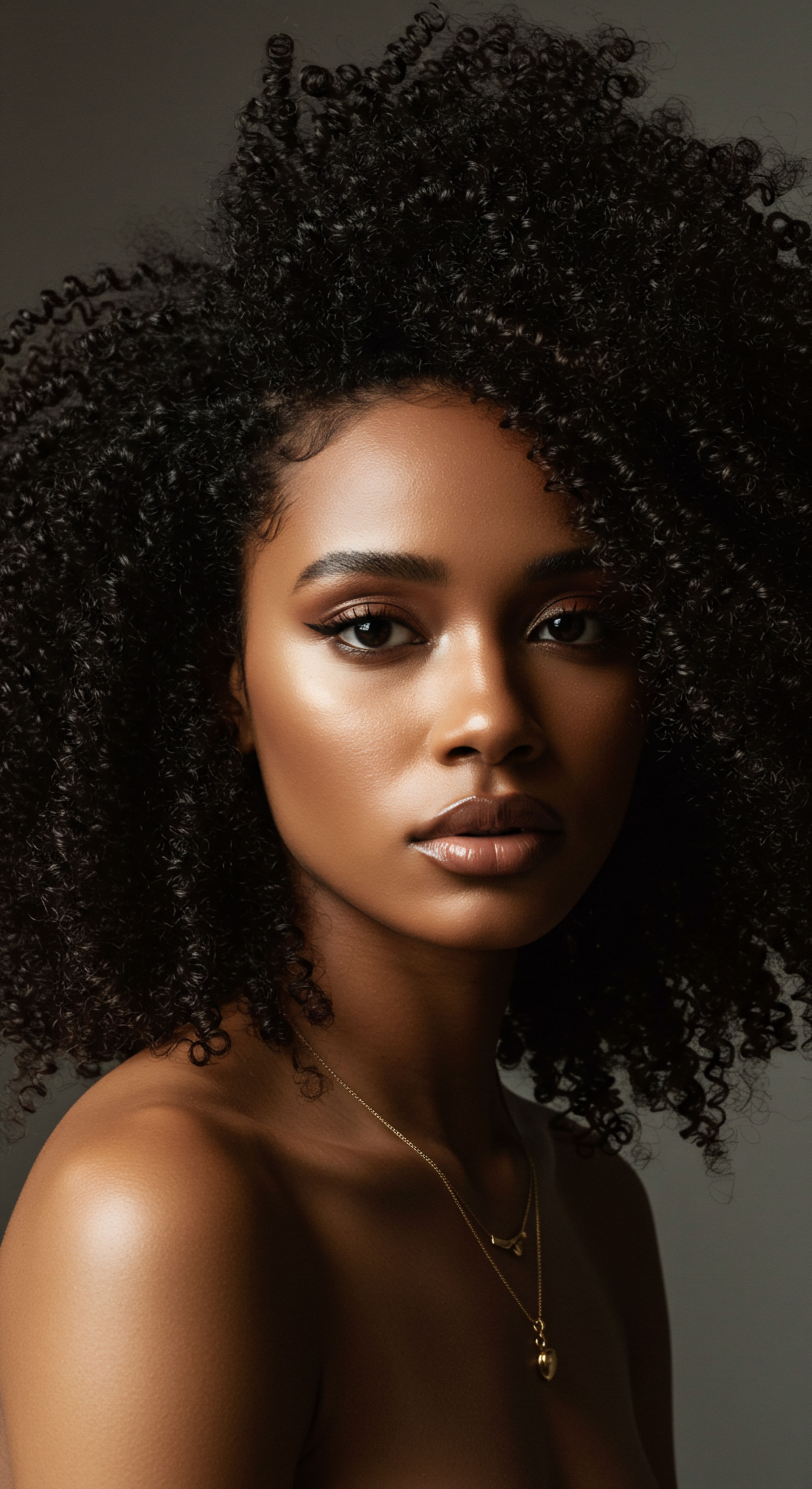
Roots
The quiet hum of water flowing from our taps often goes unnoticed, a constant presence in our daily rituals. Yet, this seemingly simple element, so vital to life, holds a profound influence over the very strands that crown our heads. For those with textured hair, whose coils and kinks possess a unique structure and responsiveness, the quality of this water can write a complex story upon each curl and wave.
It is a story whispered in the way our hair feels after a wash, in the subtle shifts of its behaviour, and in the long-term health of our scalp. Understanding this fundamental connection begins with acknowledging water as more than just a cleansing agent; it is a dynamic medium carrying dissolved minerals and chemicals, each capable of leaving its distinct mark on our hair’s delicate architecture.

What Is Water Quality in Hair Care?
Water quality, when viewed through the lens of hair health, extends beyond mere potability. It encompasses a spectrum of characteristics that dictate how water interacts with our hair and scalp. At its heart lie the dissolved solids and chemical treatments present in the water supply. These components, though invisible to the eye, become active participants in our hair care practices.
They can alter the very environment in which our strands exist, affecting everything from the cuticle’s integrity to the hair’s ability to absorb moisture and nutrients. A truly comprehensive approach to textured hair care must account for these unseen forces.

The Elemental Constituents of Water
Our tap water, whether sourced from deep underground wells or vast surface reservoirs, carries a unique fingerprint of dissolved substances. The most commonly discussed are the minerals that contribute to water hardness ❉ Calcium and Magnesium ions. These positively charged ions are picked up as water travels through geological formations. Beyond these, water may also contain trace amounts of heavy metals like copper or iron, often originating from older plumbing systems or environmental factors.
Furthermore, municipal water supplies frequently include disinfectants such as Chlorine or Chloramine, added to eliminate harmful bacteria and pathogens. Each of these elements possesses distinct properties that can interact with hair proteins, lipids, and even styling products, shaping the hair’s response to cleansing and conditioning. The precise composition of these elements dictates the water’s impact.
Water quality, often an unseen factor, significantly influences hair health through its mineral and chemical composition.

The Hair Strand’s Fundamental Response to Water
At a microscopic level, hair is a complex structure primarily composed of keratin proteins. The outermost layer, the Cuticle, consists of overlapping scale-like cells. These scales are designed to lie flat, providing a protective barrier and contributing to shine and smoothness. When hair comes into contact with water, especially water with a higher pH or certain mineral content, these cuticle scales can lift.
This opening of the cuticle exposes the inner cortex, making the hair more vulnerable to damage and affecting its ability to retain moisture. The interaction is immediate and continuous, a silent conversation between water and hair that unfolds with every wash. Understanding this fundamental dialogue is the first step toward mitigating any adverse effects and cultivating vibrant, healthy strands.
- Calcium Ions ❉ Often found in hard water, these ions can deposit on the hair’s surface, creating a rough texture and diminishing shine.
- Magnesium Ions ❉ Also present in hard water, magnesium contributes to mineral buildup, potentially weighing down strands and making them feel stiff.
- Chlorine ❉ A common disinfectant, chlorine strips natural oils from hair, leading to dryness, brittleness, and potential color alteration.
| Impurity Type Calcium & Magnesium (Hardness) |
| Source Groundwater, rock formations |
| Typical Hair Effects Dullness, stiffness, product buildup, reduced lather |
| Impurity Type Chlorine & Chloramine |
| Source Municipal water treatment |
| Typical Hair Effects Dryness, brittleness, color fading, scalp irritation |
| Impurity Type Copper & Iron |
| Source Old pipes, natural deposits |
| Typical Hair Effects Discoloration (green/orange tints), accelerated damage |
| Impurity Type High pH Water |
| Source Natural alkalinity, certain treatments |
| Typical Hair Effects Cuticle lifting, increased mineral uptake, dryness |
| Impurity Type These impurities can accumulate over time, particularly on porous or damaged hair. |

Ritual
Our daily hair care practices are more than just routines; they are intimate rituals, moments of connection with our strands. Yet, within these very rituals, the silent qualities of water can either elevate or diminish our efforts. For those tending to textured hair, where every curl and coil holds its own unique story, the water flowing from the faucet becomes a co-conspirator in the cleansing and conditioning dance. This section invites us to consider how our water’s composition shapes the very experience of washing, detangling, and styling, offering gentle guidance on how to adapt our rituals for optimal results.

How Does Water Hardness Affect Product Performance?
The presence of calcium and magnesium ions, the hallmarks of hard water, can dramatically alter the efficacy of our beloved hair care products. These mineral ions react with the cleansing agents in shampoos, particularly anionic surfactants, forming insoluble precipitates. This reaction reduces the shampoo’s ability to lather effectively, making it feel as though the product is not working as it should. A lack of rich lather can lead to the subconscious use of more product, or a perception that hair is not truly clean, prompting more vigorous washing.
Furthermore, these mineral deposits can accumulate on the hair surface, creating a film that hinders the penetration of conditioners and styling products. The hair might feel rough or coated, despite diligent application of moisturizing treatments. This interaction transforms the sensory experience of hair care, making it a less satisfying endeavor.

The Science of Mineral Deposition on Hair
Hair, especially textured hair, often carries a slight negative charge on its surface, particularly when the cuticle is open or damaged. The positively charged calcium and magnesium ions found in hard water are drawn to these negatively charged sites, binding to the hair fiber. This binding can occur both on the outer cuticle and, for more porous or damaged strands, within the inner cortex. Over time, these mineral deposits build up, leading to a dull appearance, reduced flexibility, and increased friction between individual strands.
This mineral layer can also interfere with the hair’s natural moisture balance, making it feel drier and more prone to tangling. The scientific understanding of this adhesion helps us comprehend why hard water can make hair feel so different from soft water.
Hard water minerals can coat hair strands, diminishing product efficacy and altering hair’s tactile feel.

Adapting Cleansing Routines for Different Water Types
Consciously adapting our cleansing rituals to the water quality at hand is a step toward greater hair health. In areas with hard water, incorporating chelating shampoos can be profoundly beneficial. These shampoos contain ingredients that bind to the mineral ions, preventing them from depositing on the hair and allowing them to be rinsed away. For those seeking gentler alternatives, an apple cider vinegar rinse, with its acidic pH, can help to dissolve some mineral buildup and smooth the cuticle, restoring a sense of balance.
Conversely, in very soft water areas, hair might feel overly slippery and limp, sometimes requiring lighter conditioning products or a slightly more clarifying shampoo to avoid over-moisturization. The key lies in observation and responsive adjustment, tailoring the ritual to the water’s unique personality.
- Chelating Shampoos ❉ These products contain ingredients that actively bind to hard water minerals, preventing their buildup on hair.
- Acidic Rinses ❉ Solutions like diluted apple cider vinegar can help to neutralize alkaline hard water and remove mineral deposits.
- Water Filters ❉ Showerhead filters can significantly reduce mineral and chemical content, improving water quality at the point of use.
For individuals with textured hair, which often possesses a higher porosity due to its natural curl pattern, the impact of water quality can be even more pronounced. Highly porous hair has a more open cuticle, allowing for greater absorption of both beneficial ingredients and unwanted minerals. This means that hard water deposits can accumulate more readily and deeply, making the hair feel rougher and more resistant to styling.
Conversely, soft water can sometimes cause highly porous hair to feel oversaturated, leading to a sensation of limpness or prolonged drying times. The delicate balance required for textured hair care makes understanding water’s role particularly relevant.

Relay
The journey of water to our strands is a relay, a complex passage where each phase leaves an imprint. Moving beyond the immediate tactile experience, we step into a deeper exploration of how water quality influences hair at its most fundamental, structural level, and how these influences resonate across cultural practices and scientific understanding. This section seeks to connect the seemingly disparate worlds of environmental chemistry, trichological research, and ancestral wisdom, revealing the intricate dance between water and hair that shapes its vitality and appearance.

How Do Specific Water Contaminants Affect Hair at a Molecular Level?
The impact of water quality extends beyond visible deposits or altered product performance. Certain contaminants interact with hair at a molecular level, causing changes that compromise its structural integrity. Chlorine, for instance, a ubiquitous disinfectant in municipal water, is a powerful oxidizing agent. When hair is repeatedly exposed to chlorinated water, this oxidant can degrade the hair’s protective lipid layer and even attack the disulfide bonds within the keratin protein structure.
These disulfide bonds are responsible for much of hair’s strength and elasticity, and their disruption leads to increased brittleness, split ends, and a straw-like texture. Furthermore, chlorine can react with melanin, the pigment in hair, leading to unwanted color changes, particularly for chemically treated or lighter strands.

The Unseen Influence of Heavy Metals on Hair Protein
Beyond chlorine, trace amounts of heavy metals, such as Copper and Iron, present in tap water, pose a subtle yet significant threat to hair health. These metals can deposit onto the hair shaft, especially in porous or chemically treated hair. Once attached, certain metal ions, particularly copper, can act as catalysts in oxidative reactions. This means they accelerate the formation of damaging free radicals when exposed to light or other oxidizing agents.
A study conducted by Dr. Jennifer Marsh and her team at Procter & Gamble, analyzing hair samples from 450 women globally, revealed varying levels of copper present in everyone’s hair, with some individuals exhibiting levels exceeding 500 parts per million. This research suggests that as copper accumulates, it contributes to increased protein degradation and can accelerate sun damage, leading to split ends, flyaways, and a dull appearance. This unseen process compromises the very building blocks of the hair, making it more vulnerable to external stressors and less able to retain its natural resilience.
Copper ions in water can accelerate protein degradation in hair, even without UV exposure, a subtle yet significant damage pathway.
The mechanisms at play are complex. Copper ions, for example, can mediate the decomposition of lipid peroxides present in hair, generating highly reactive alkoxyl radical species. These radicals then react with hair proteins and lipids, causing molecular modification and ultimately structural degradation. This degradation is distinct from simple mineral buildup; it represents a fundamental weakening of the hair fiber from within.
The insidious nature of this damage means that its effects might only become apparent over time, manifesting as persistent dryness, breakage, or a general lack of vitality that seems resistant to conventional conditioning treatments. Understanding this intricate interplay between water chemistry and hair biology provides a deeper perspective on cultivating true hair wellness.

Can Water PH Truly Alter Hair’s Internal Structure?
The pH of water, a measure of its acidity or alkalinity, plays a critical role in how hair behaves. Hair itself has an acidic mantle, with a typical pH ranging from 4.5 to 5.5. Water with a pH outside this range can affect the hair’s cuticle. Highly alkaline water (high pH) causes the cuticle scales to lift and swell, making the hair feel rough and prone to tangling.
This opening of the cuticle also increases the hair’s susceptibility to absorbing minerals and chemicals present in the water, further exacerbating potential damage. Conversely, acidic water helps to smooth and close the cuticle, enhancing shine and reducing porosity. While short-term exposure to varying pH levels might not cause irreversible internal structural damage, consistent use of highly alkaline water can lead to chronic cuticle lifting, leaving the hair vulnerable and less resilient over time.
- Hair’s Isoelectric Point ❉ The point at which hair carries no net electrical charge, typically around pH 3.67.
- Alkaline Water Effects ❉ High pH water causes cuticle swelling and deprotonation of hair proteins, increasing mineral ion binding.
- Acidic Water Benefits ❉ Low pH water helps to flatten cuticle scales, reducing friction and enhancing hair’s natural sheen.
The cultural context of water quality and hair care offers a compelling lens through which to understand these scientific principles. In many regions of the world, access to specific water sources has historically shaped hair practices. Communities living near mineral-rich springs might have developed traditions of using specific plant-based rinses to counteract hard water effects, while those with naturally soft rainwater might have focused on different aspects of hair preservation. These practices, passed down through generations, often embody an intuitive understanding of water’s impact, predating modern scientific analysis.
For instance, the traditional use of fermented rice water, which has a slightly acidic pH, in certain Asian hair care rituals, aligns with the scientific understanding of pH’s benefits for cuticle health. This convergence of ancestral wisdom and contemporary science underscores the profound, interconnected relationship between our environment, our traditions, and the vitality of our hair.

Reflection
As we conclude this exploration into the unseen currents that shape our hair, a quiet truth settles ❉ water, in its varied forms, is not merely a passive agent in our care rituals. It is an active participant, a silent partner in the health and appearance of our textured strands. From the elemental mineral content to the subtle shifts in pH, each characteristic of our water supply tells a story upon our hair. Understanding this story, recognizing the delicate balance between water and hair, grants us a deeper reverence for our daily practices.
It invites us to consider our choices with greater intention, whether through the adoption of filters, the selection of chelating products, or simply a more attuned observation of how our hair responds. In this awareness lies the opportunity to move beyond reactive solutions, to cultivate a relationship with our hair that is truly informed, responsive, and ultimately, deeply nurturing. Our hair, a living testament to our heritage and our self-care, deserves this mindful attention to the very source of its cleansing and hydration.

References
- Evans, A. O. Marsh, J. M. & Wickett, R. R. (2011). The uptake of water hardness metals by human hair. Journal of Cosmetic Science, 62(4), 383-391.
- Marsh, J. M. Davis, M. G. Flagler, M. J. Sun, Y. Chaudhary, T. Mamak, M. McComb, D. W. Williams, R. E. A. Greis, K. D. Rubio, L. & Coderch, L. (2015). Advanced hair damage model from ultra-violet radiation in the presence of copper. International Journal of Cosmetic Science, 37(4), 430-438.
- Marsh, J. M. Davis, M. G. Flagler, M. J. Sun, Y. Chaudhary, T. Mamak, M. McComb, D. W. Williams, R. E. A. Greis, K. D. Rubio, L. & Coderch, L. (2015). Oxidative Modification in Human Hair ❉ The Effect of the Levels of Cu (II) Ions, UV Exposure and Hair Pigmentation. Photochemistry and Photobiology, 91(6), 1385-1390.
- Saranya, M. Rajendran, K. & Arumugam, P. (2018). Scanning electron microscopy study of hair shaft changes related to hardness of water. International Journal of Trichology, 9(3), 101–104.
- Saleh, M. Yalvaç, M. Sime, F. & Mazmanci, M. A. (2019). Study the Effect of Hair Style Products on the Quality of Domestic Wastewater- Wax as Case Study. Turkish Journal of Engineering, 3(2), 97-101.
- Pyo, H. K. Yoo, H. G. & Yoon, J. S. (2007). The effect of copper on hair growth. Journal of Dermatological Science, 45(2), 127-134. (While this reference talks about copper’s role in growth, the broader implication of copper interaction with hair is relevant).
- Srinivasan, R. & Rangachari, C. (2013). Effects of Hard Water on Hair. Journal of Clinical and Diagnostic Research, 7(12), 2697-2699.
- Robbins, C. R. (2012). Chemical and Physical Behavior of Human Hair. Springer. (A foundational book on hair science, covering water interactions).
- Gavazzoni Dias, M. F. R. (2015). Hair Cosmetics ❉ An Overview. International Journal of Trichology, 7(1), 2-15.
- Wang, Y. Li, S. Zhao, Y. Liu, W. & Li, L. (2023). Advances in Permeation of Solutes into Hair ❉ Influencing Factors and Theoretical Models. Cosmetics, 10(2), 52.